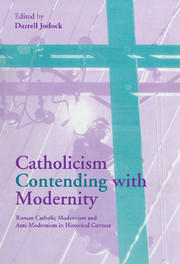 Catholicism Contending with Modernity
Catholicism Contending with Modernity Published online by Cambridge University Press: 30 October 2009
On 8 September 1907 Pope Pius X issued Pascendi dominici gregis, an encyclical in which he condemned “Modernism” as the “synthesis of all heresies.” The Modernists, he said, “lay the axe not to the branches and shoots, but to the very root, that is, to the faith and its deepest fires … so that there is no part of Catholic truth from which they hold their hand, none that they do not strive to corrupt.” In the pope's mind the Modernists posed a threat to the church that was all the more dangerous because “the partisans of error are to be sought not only among the Church's open enemies; they lie hid, a thing to be deeply deplored and feared, in her very bosom and heart.” In Pascendi this “Modernism” was defined in such an encompassing way, those labeled “Modernists” were condemned with such vehemence, and the measures prescribed to prevent its growth were so stringent that it virtually slammed the door on any historical study of the Bible, on theological creativity, and on church reform. The door would remain closed for the next three decades. Its consequences were serious and far-reaching.
What kind of perceived threat elicited this response? Who were the Modernists and what did they advocate? And what was the origin of the anti-Modernism that reached full expression in this encyclical? These questions, and others like them, will occupy this entire volume.
To save this book to your Kindle, first ensure [email protected] is added to your Approved Personal Document E-mail List under your Personal Document Settings on the Manage Your Content and Devices page of your Amazon account. Then enter the ‘name’ part of your Kindle email address below. Find out more about saving to your Kindle.
Note you can select to save to either the @free.kindle.com or @kindle.com variations. ‘@free.kindle.com’ emails are free but can only be saved to your device when it is connected to wi-fi. ‘@kindle.com’ emails can be delivered even when you are not connected to wi-fi, but note that service fees apply.
Find out more about the Kindle Personal Document Service.
To save content items to your account, please confirm that you agree to abide by our usage policies. If this is the first time you use this feature, you will be asked to authorise Cambridge Core to connect with your account. Find out more about saving content to Dropbox.
To save content items to your account, please confirm that you agree to abide by our usage policies. If this is the first time you use this feature, you will be asked to authorise Cambridge Core to connect with your account. Find out more about saving content to Google Drive.